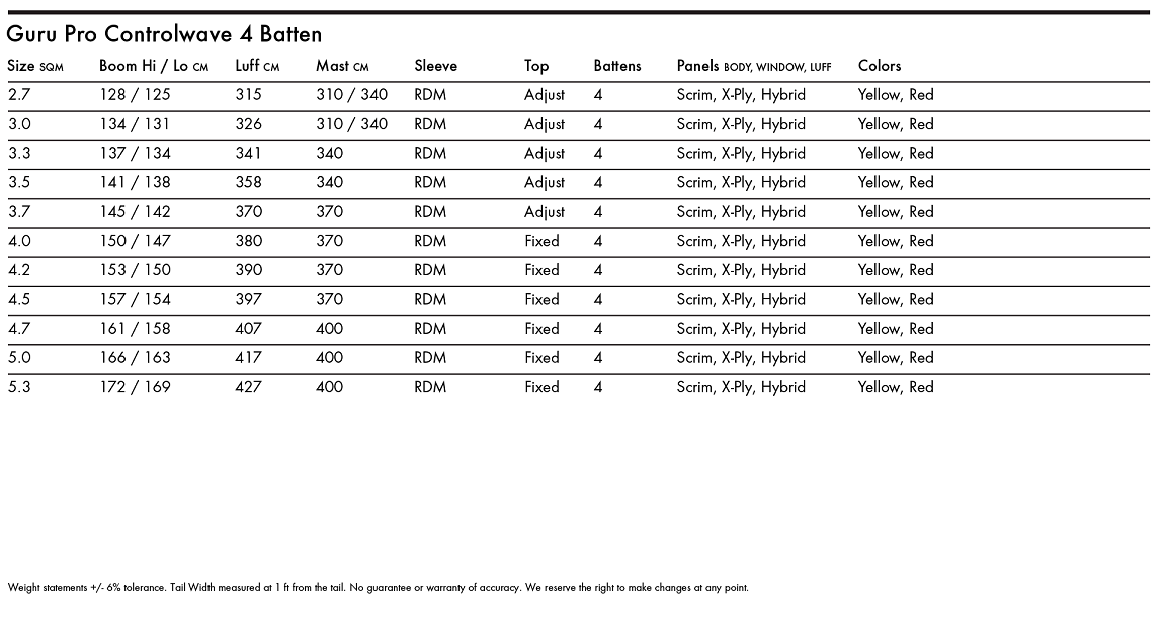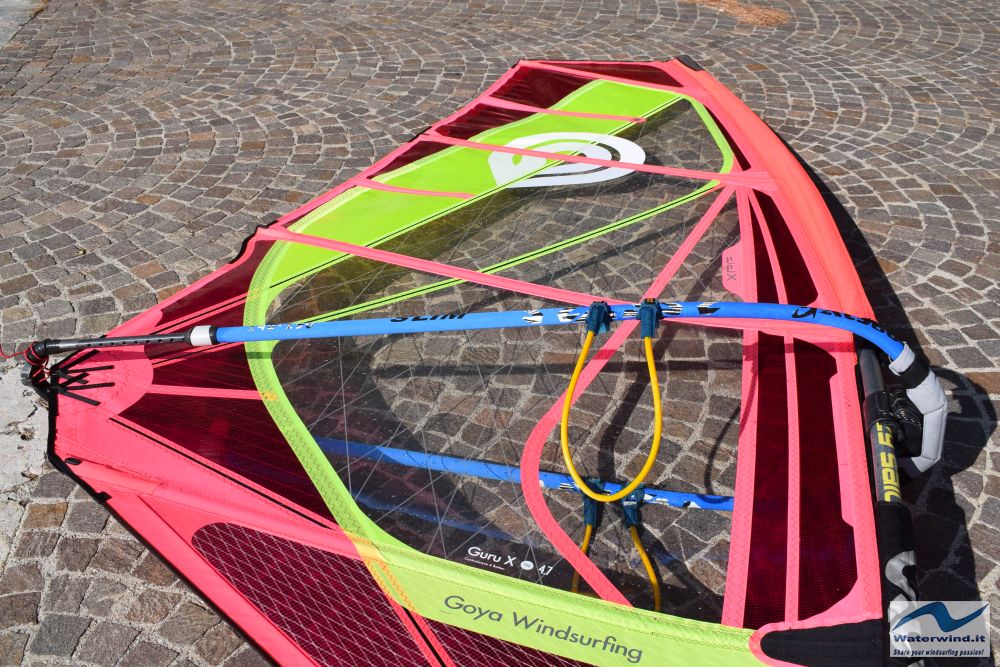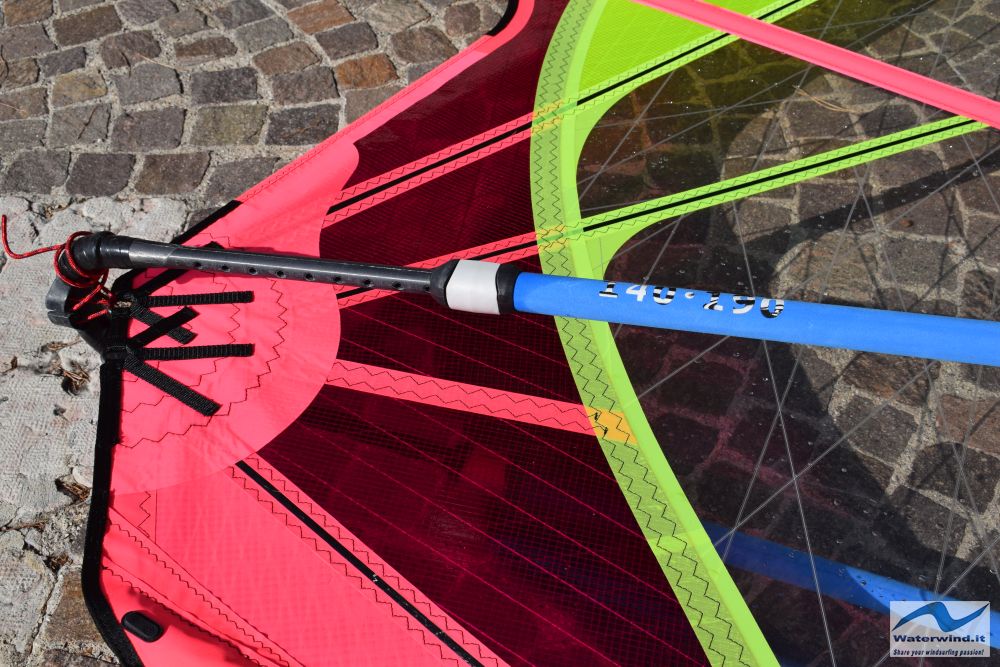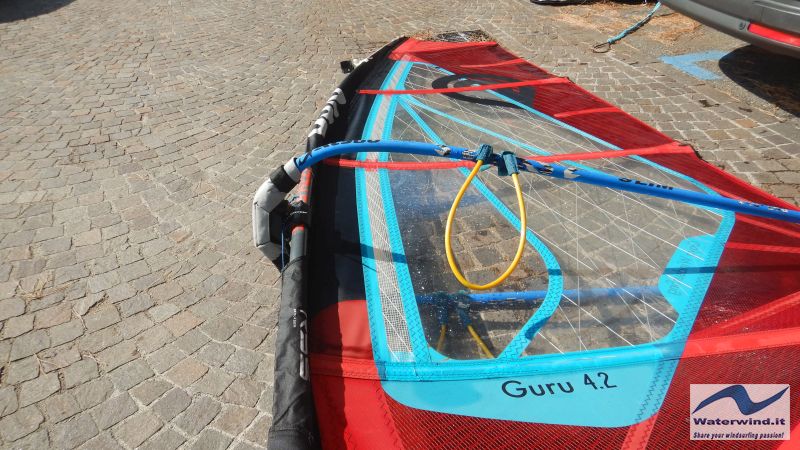The Goya Guru is the 4 batten wave sail from the Hawaiian brand of windsurfing equipment. It is referred to as "Control wave", comparing it to Goya other 4 battens sail, the Banzai, defined as "Power wave" sail. After reviewing the 2020/2021 Guru model, we also had the opportunity to test the 2018 version.
Windsurfing, sails test: Goya Guru Pro 2018
Although it is a product of a few years ago, it seemed interesting to share, with you all, our impressions of the 2018 model, since some differences emerged, not only with the Banzai, but also with the newer model. Moreover, someone may come across one of this sail to be evaluated in the second-hand market.
Before illustrating our considerations on this sail, first of all, let's see together what are the technical characteristics of this 2018 version. Below we report the technical data of the sail, in various sizes, taken from the Goya sails website.

Unlike the Banzai, in 2018 the Guru was not produced both in the yarned version and in the version with the non-reinforced X-Ply (Clear window), but only in the Pro version, almost completely textured (with the exception of the central window / panel ), which is more robust. The 2020/2021 model was also produced only in the X Pro version, with reinforced X-Ply (read the review of the Goya Guru 2020/2021 XPro). As a default feature on Goya sails, also on this Guru model, there are two distinct clew rings, which allow two different Control Stretches to be tensioned, the upper one in case of lighter wind, the lower one in case of stronger wind. In doing so, the sail offers a wide range of manageable wind.
Below, we present some photos of the 2018 model and the 2020 model, to highlight some differences.
The main differences that are noted are:
1) The upper part of the sail, near the leech, is divided into two oblique panels, in the 2020 model between leech and Control Stretch (see yellow panel near the logo, and adjacent purple panel), while it is undivided in the 2018 model.
2) The half battens (and in particular the higher one) do not reach the first control stretch in the 2018 model, while they reach it in the 2020 model (which no longer has, in fact, the scalloped leech reinforcement to stabilize the sail profile).
3) There are also differences in the panels near the mast sleeve (in the 2018 model, they're semi-transparent).
4) In the 2020 model, there is a reinforcement at the end of the low batten, close to the mast sleeve.
There are no particular differences in the clew zone.



Regarding the construction, Goya reports as follows:
Scrim Body Panels. The colored Scrim material used in the main panels offers super strong durability, super light weight and a supple and alive feel throughout the sail.
X-Ply Window Panels. X-Ply offers the same weight and feel of a clear window construction. The difference is increased durability through improved tear resistance. X-Ply film reinforced with yarns is incredibly tear resistant, the perfect body panel material for people looking for maximum durability. Featured on Banzai X, Guru, Scion.
Vinyl Window. Vinyl delivers a flexible feel to the sail as a whole, and the window, with a little maintenance, will stay clear for the life of the sail.
Hybrid dacron/scrim luff panels, Carbon Stretch Control, Poly Clew Titanium Clew Rings, Rip Stop Sleeve and a Molded Tack Fairing round off the peak quality package. Sleeve cut treatments as well as tack and foot reinforcements are now folded to increase durability and prevent edge fraying. A wider scalloped upper leech reinforcement prevents breakdown of the leech from fluttering in strong wind conditions such as Omaezaki, the Gorge and Pozo.
Regarding the sail behavior, the manufacturer describes it as follows:
Guru delivers smooth and easy power and effortless handling in strong wind. The cut of the sail, combined with the vinyl window make the sail feel easy and light in your hands, allowing for long sessions in challenging conditions with minimal fatigue. The Guru excels in all wave and wave style sailing conditions, down the line waves, onshore waves and powered up chop. It pairs with the full range of fin set ups, single, twin, thruster or quad. In addition to a flexible feel, the PVC window, with a little maintenance, will stay clear for the life of the sail.
Wildly popular with sailors looking for the ultimate flexy feel, easy power, massive range, monofilm free durability sail, the Guru continues to build its legacy. New window shapes increase the viewing area through the sail. Updated tack film materials strengthen the foot and increase the sail’s visual impact and style. New combination nylon/composite leech mini battens stabilize the leech trailing edge making the sail quieter in the hands and also more durable against material breakdown caused by an excessively fluttering leech.
For all the details, we reccomend you to adress directly to the manufacturer's website.
Our impressions
The sail was tested with a 91% Carbon Ezzy Hookipa 370 RDM mast, slightly stiffer than the recommended Goya mast (although both manufactured by Nolimitz), making the sail more powerful.
The sail has so far been tested at Pra' de la fam, Lake Garda, with 30-35 knots of Peler, in bump and jump conditions. We will add any further considerations when we will have the opportunity to try the sail even in wave conditions worthy of note.
The first tests carried out on Lake Garda confirmed the pleasant sensation of lightness and neutrality in the hands, of stability when riding on straight line, and of a wide manageable wind range (making the most of the two clew rings). Surely, it is a more docile and easier sail, that gives less abrupt acceleration, under gusts, than the Banzai. The glide start is less sudden, and less nervous when sailing straight. Furthermore, as emerged in the previous tests, the Guru tolerates gusty wind better than the Banzai, responding less directly and immediately to variations in wind intensity.
The sail in the 2018 version, however, appeared to us slightly more powerful and less neutral than the 2020 version, with more decisive accelerations, under gusts. It is the same impression we had when trying the Banzai 2018 (read the review) and the Banzai 2019 (read the review). Probably, Goya made the choice to make the sails a little more neutral (responding to market demands), moving from the 2018 models to the following year ones, as Paul Karaolides, Goya photographer (and owner of the agency "Fishbowl diaries"), whom we met in Oman, in July 2019, had also confirmed to us. We will keep you updated if we have other evaluations to share.
Read also the Goya Banzai 2020 review.
Without your Support, Waterwind wouldn't exist. Become our supporter!
If you want to advertise with us, read here, or contact us.
Collaborate with us. Read here!
Buy our Gadgets! Visit our YouTube channel!
A video of me during the sailing test, at Pra' de la Fam (Lake Garda)








